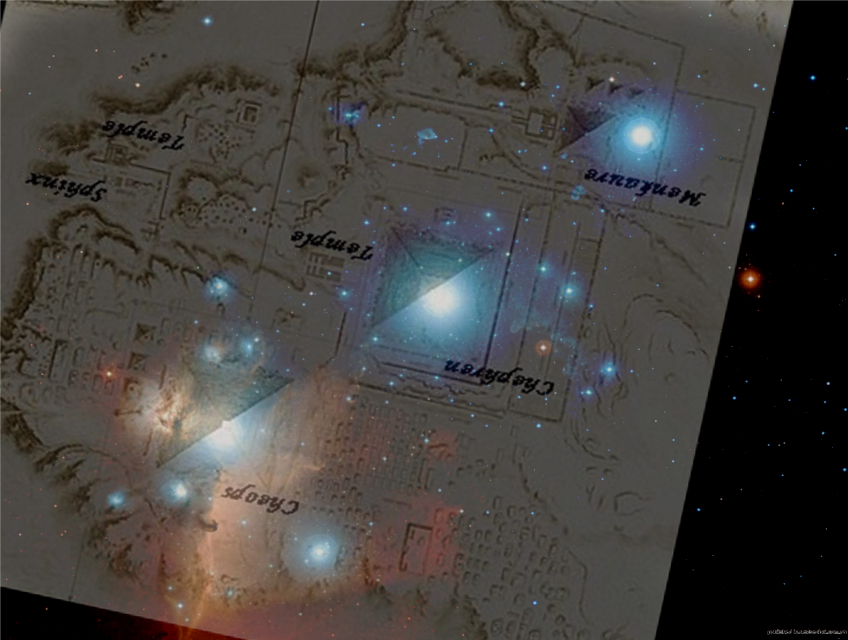Today’s discussion comes to us thanks to the investigative sleuthing of
Le site d’Irna, where we find an
interesting inquiry into the sources of a French-language documentary about the pyramids of Egypt. As you can see for yourself at the link,
Jacques Grimault’s documentary film
La Révélation des Pyramides (2010) is filled with faulty sources and pseudo-scholarly nonsense in service of a bizarre claim that “pyramid” sites at Easter Island, South America, Egypt, and China all align along two lines intersecting at Giza—as, indeed, Great Circle mathematics shows that one can make any two points “align” using such methods. According to the film, the only explanation for advanced pyramid technology is a lost Atlantis-like civilization.
We’ve heard that one before.
What I found interesting enough to report here is the misuse of an ancient source in service of this modern myth. According to the film, as translated at the above link, “Twenty centuries before [the Abbé Moreux], Agatharcides of Cnidus had stated that the Great Pyramid was a geographical image of the Earth.”
That ought to be easy to check, right?
But not so!
We start in modern times. In 2007, the ex-neo-Nazi diffusionist Frank Joseph wrote in
Opening the Ark of the Covenant that “the Greek geographer and historian Agatharchides of Cnidus concluded that it [the Great Pyramid] ‘incorporated fractions of geographical degrees.’” Thus, it was a model of the earth itself. Robert Schoch agreed in 2005’s
Pyramid Quest. Earlier, in 1995, John Anthony West (who, you will recall, believes I am evil and attempting to destroy him) wrote in
The Traveler’s Key to Ancient Egypt that “all allusions to the pyramid as an earth model could be traced back to the peripatetic Greek philosopher Agatharcides of Cnidus.” Similar material appears in Colin Wilson’s and Rand Flem-Ath’s
The Atlantis Blueprint (2000), repeating nearly verbatim material in Wilson’s
From Atlantis to the Sphinx (1996) and Wilson’s and Damon Knight’s
Mammoth Encyclopedia of the Unsolved (2000); and these books give exact measurements allegedly derived from Agatharcides. These numbers are found even earlier in Charles Berlitz’s
Mysteries from Forgotten Worlds (1972), again attributed to Agatharchides.
But turning back any further and we hit a wall. The oldest reference is from 1971, when the classical scholar Livio Catullo Stecchini (1913-1979), a defender of Velikovsky and pyramid numerology, wrote an appendix to Peter Tompkins’s
Secrets of the Great Pyramid (1971), wherein the author makes the first version of the claim. As
Le site d’Irna quotes, Stecchini presented extraordinary detail about Agatharchides compared with his extant works:
The interesting feature of Agatharchides’ report about the dimensions of the Pyramid is that he excludes the pyramidion from the reckoning. [...] From Agatharchides’ account one gathers that the Great Pyramid of Giza was topped by such a pyramidion, "small pyramid," as the Greeks called it. In the case of this Pyramid, at least, the pyramidion was used to achieve a mathematical result. (page 372)
[...] the top of the Pyramid was conceived as cut off in the computation presented by Agatharchides.
An essential point of Agatharchides’ account is that he describes the Pyramid as having an apothem which measures a stadium up to the pyramidion and having a side which measures 1 1/4 stadia. The term stadium has a double meaning: it refers to 1/10 minute of degree and it refers to a specific unit of measurement. Agatharchides uses the term in both senses. (page 372)
From Agatharchides we learn that the apothem up to the pyramidion had a length of a stadium, that is, 1/10 of a minute of degree. (page 373)
Agatharchides interprets the dimensions of the Pyramid also by taking the word stadium as referring to the stadium of 600 geographic feet. (page 373)
According to Agatharchides the side of the Pyramid is 1 1/4 stadia or 750 feet (230,847 millimeters), and the apothem is a stadium or 600 feet. The side of the base of the pyramidion is 9 feet. The figures indicate that Agatharchides was not concerned with presenting the actual dimensions of the Pyramid, but in illustrating the mathematical principles according to which the Pyramid had been conceived. (page 373)
Having started with the mentioned meridian triangle, Agatharchides cut off the side so as to reduce the apothem to 600 feet and the base to 371 feet, excluding the part of the base below the half of the pyramidion. (page 374)
Not a lick of this material appears in ancient sources, which amount to a few paragraphs of fragments from Photius, Diodorus, Strabo, and others. So far as I am aware, the first authors to claim the Great Pyramid represented the circumference of the earth were John Wilson, author of
The Lost Solar System of the Ancients Discovered (1856) and Edme François Jomard, editor of the
Description de L’Égypt. The warrant, as Jomard had it, was that the Pyramid’s coffer was so close to the French meter (itself designed to be one ten-millionth of the distance from the equator to the North Pole) that the Pyramid must therefore embody astronomically-derived measurements. Other authors, like Hekekyan Bey and A. Dufeu similarly argued that the pyramid encoded the circumference of the earth in its various measurements, if multiplied by special numbers only they were able to deduce.
I have no idea where Stecchini got his material, but I can make a stab.
Flinders Petrie measured the base of the Great Pyramid and, after doing some restorations to find the size with the missing casing stones, he suggested it as being 440 royal cubits per side, using simple geometry calculated from the height of the pyramid, 280 cubits. Petrie then explained that these 440 cubits were equivalent to 1.25 stadia, giving five stadia for the whole circumference. Petrie also gave a chart explaining the various measurements and their relationship to each other and to the earth. Since Petrie is the first pyramid writer to give these particular numbers (though the 440 cubit claim apparently predates him), he must therefore be the originator of the measurements cited by Stecchini.
I do not know, though, why Stecchini would make up a fake ancient source for Petrie’s measurements. The only insight I can offer is that a character by the name of Agatharchides was the subject of an ancient bit of pseudo-scholarly fraud. A certain non-existent Agatharchides of Samos was cited in the
Parallela Minora of pseudo-Plutarch (2.1), a document that many scholars feel was meant as a parody of Plutarch, and Alan Cameron (
Greek Mythography in the Roman World, Oxford, 2004) points out that this fellow never existed, though it did not stop centuries of scholars from puzzling over whether he was real and if so what happened to him and his books. Perhaps Stecchini was honoring the dubious citations of this figure with his own bogus citation of another by that name, but, alas, Stecchini is long dead and all we have is dozens upon dozens of pseudo-scholars repeating his claims as though they were ancient fact.
I put that cac troll on my ignore list from time.






 ,i didn't know Napoleon posted on the
,i didn't know Napoleon posted on the  The Pyramids found in the Antarctica are even more a mystery since no one is basically allowed to explore there. Some say Atlantis might be hidden under all the ice and snow. Others say it's a huge hole that goes into the earth.
The Pyramids found in the Antarctica are even more a mystery since no one is basically allowed to explore there. Some say Atlantis might be hidden under all the ice and snow. Others say it's a huge hole that goes into the earth. 




